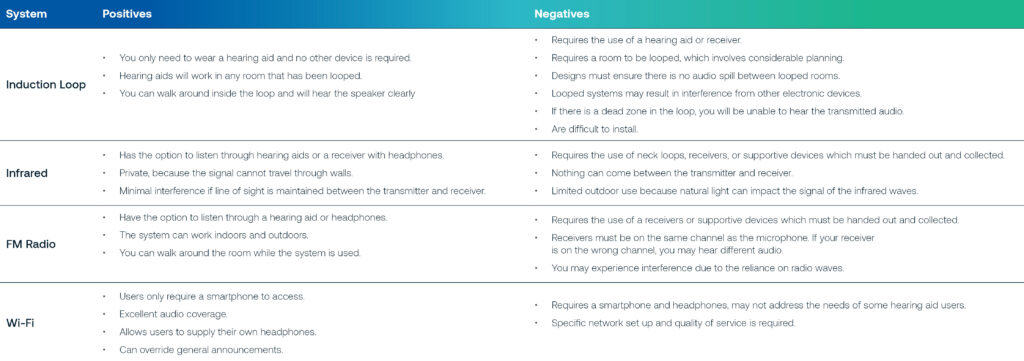What is Hearing Augmentation?
Hearing augmentation systems are used to improve the hearing ability of people in a variety of different contexts. Typically, a system will include a transmitter and receiver with the purpose of enhancing sounds. Systems can be used to enhance speech, general conversation, or music. Hearing Augmentation systems are often required to satisfy building code and accessibility requirements.
To meet Australian standards, hearing augmentation system are required in public buildings, and there are a variety of technology options available to meet this requirement. However, there are grey areas regarding the specific allowances and specification requirements of hearing augmentation systems that are not covered in current standards.
In our experience, there is no gold-standard hearing augmentation system, and no solution is perfect or will perfectly fit the needs of every end-user or facility. In this article, we provide an overview of the different hearing augmentation technology options available, discuss their positive and negatives, and outline our recommendations for hearing augmentation system design.
What Hearing Augmentation is not
Hearing augmentation is not hearing assistance.
Hearing assistance is an individual’s device, such as a hearing aid or a cochlear implant. The individual’s device is selected in consultation with an audiologist based on an individual’s auditory deficiencies. Hearing assistance devices support an individual in their day-to-day hearing; regardless of their location or what hearing augmentation systems are around.
Increasingly, phones can also be used as a remote microphone to communicate directly to a hearing assistance device, or even used by standard Bluetooth headphones.
Australian Hearing Augmentation Requirements
The following requirements are typically referenced regarding the provision of hearing augmentation systems:
National Construction Code (2019) Building Code of Australia – Volume One, Australian Building Codes Board.
Section 3.7 Hearing Augmentation stipulates two types of hearing augmentation system:
(a) an induction loop, it must be provided to not less than 80% of the floor area of the room or space served by the inbuilt amplification system; or
(b) a system requiring the use of receivers or the like, it must be available to not less than 95% of the floor area of the room or space served by the inbuilt amplification system.
Item (b) then outlines a guide to the number of receivers needed to be provided depending on the capacity of the space.
Furthermore, AS1428.5-2010 (R2016) requires a hearing augmentation system be provided where an in-built amplification system such as telecommunications systems, occupant warning systems, public address system or telephone services are installed in a public building or space designed for 5 or more people.
Appropriate signage must also be provided, regardless of what system is implemented.
Hearing Augmentation System Options
Induction Loops
Alternatively referred to as hearing or audio loops, induction loops are an electromagnetic communications system that produce a signal that transmits to a user’s hearing aid when set to the telecoil setting. The induction loop signal picks up the sound broadcast by a designated microphone. When Induction Loops are used there are no options to tune into different audio streams. Therefore, if multiple loops are used in proximity, a common problem can be audio spill between rooms. Induction loop systems also requires users have a hearing aid with a telecoil and may exclude some hearing-impaired users. A designated receiver can also be used, however these often aren’t found at locations that have loops. Increasingly manufacturers are choosing Bluetooth functionality over telecoil functionality.
Infrared (IR) Hearing Augmentation
Infrared hearing augmentation system use an infrared signal to send audio from a transmitter to a personal receiver (neck loop or headphones). Like induction loops, IR hearing augmentation picks up the sound broadcast by a designated microphone. A neck loop, along with a telecoil enabled hearing aid or headphones, are required to use the system. The infrared signal cannot travel through walls, people, or objects, and the neck loop (receiver) must be in direct line of site of the transmitter. Sunlight may also cause interference to the infrared signal.
FM Radio Frequency
FM radio frequency hearing augmentation systems use Frequency Modulation (FM) radio waves to transmit sound, similar to many radio stations. FM system can be used by people with or without hearing aids, however receiving devices must be distributed and collected from users before and after their use. Unrestricted by line of site and not requiring hearing aids, FM systems allow for users to make their own volume adjustments with their receivers and provide a consistency of audio quality throughout a space.
Wi-Fi Hearing Augmentation
Wireless hearing augmentation solutions use the existing wireless network to transmit audio to an application installed on users’ smartphones. A Wi-Fi solution enables users to supply their preferred headphones or personal hearing assistance device and allows for users to access the audio wherever a wireless signal is available. A Wi-Fi solution removes the need of specific receiving devices which must be distributed and collected to use the system. However, building code still necessitates receivers are located on site. Wi-Fi systems using centralised audio processing can enable all channels to be overridden for general announcements or other messaging.
Hearing Augmentation Comparison
The following are positive and negatives that must be considered when evaluating the deployment of hearing augmentation solutions throughout your project:
Design Recommendations
When designing hearing augmentation solutions, it is critical to remember that each user’s hearing requirement is unique, and there is no clear consensus on the preferred or best hearing augmentation solution that works with someone’s hearing assistance solution.
Because there is no clear consensus from users on which system is best, we often recommend designing the hearing augmentation system to accommodate a combination of assistive technologies. In our experience, we often see the hearing technology self-select depending on the environment. For example, hearing augmentation in an outdoor auditorium typically only allows for a FM Radio or Wi-Fi option. Alternatively, a courtroom, a boardroom or meeting space, where privacy must be maintained, will self-select an infrared hearing augmentation system.
However, there is one hearing augmentation technology we advocate for as part of any broader hearing augmentation system. We believe Wi-Fi hearing augmentation provides the best solution for end-users via the combination of ease of use, flexibility, and by empowering users to use their own devices and preferred headphones. Furthermore, during the COVID-19 Pandemic there is an additional administrative requirement to sterilise any receivers after use – a Wi-Fi system completely avoids this additional requirement.
Wi-Fi hearing augmentation is a relatively new technology in the assistive hearing space. As a result, we occasionally receive feedback that Wi-Fi hearing augmentation is not compliant with the Australian standards referenced in this article. However, we believe Wi-Fi hearing augmentations use and deployment is covered by the provision:
(b) a system requiring the use of receivers or the like, it must be available to not less than 95% of the floor area of the room or space served by the inbuilt amplification system.
Whereby a “receiver” is the user’s smartphone and where the coverage of the Wi-Fi network is typically a 100% of the area of the room.
Prior to deploying a Wi-Fi based hearing augmentation solution on any project, we recommend approval from the Building Surveyor be obtained.
Final Thoughts
At UT Consulting we recognise there is no golden rule for hearing augmentation system design. We are constantly seeking guidance from users on their preferred system type. To date, our experience indicates that each user’s individual hearing requirements and organisational needs leads to different preferences in the hearing augmentation provided.
While there are clear environmental design constraints which assist in self-selecting different hearing augmentation systems, we believe Wi-Fi hearing augmentation provides the most well rounded and accessible solution for users when the organisation’s IT network allows for its use. Wi-Fi hearing augmentation deployment is subject to Building Surveyor approval.
Should you have any further questions about hearing augmentation solutions, please contact us directly on +61 3 9601 6555.

